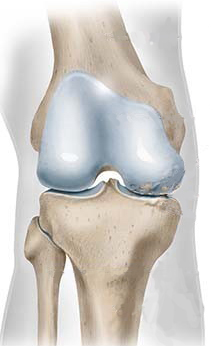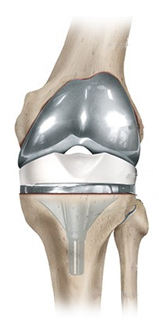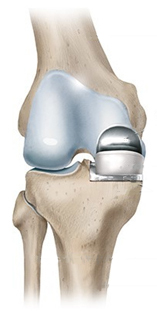PATIENT INFORMATION: Knee Endoprosthesis
WHAT FOR ?
Knee osteoarthritis means that the cartilage in the knee joint has begun to weaken. It cannot be cured in order to make all the symptoms disappear. But you can do something about the discomfort: train the muscles and do exercises. Not everyone who has discomfort needs an implant.
When deciding on a knee implant, these criteria do matter:
- Age, severity and duration of discomfort, other treatments, health conditions (other diseases), expectations.
- An increased risk of developing knee osteoarthritis exists in cases of severe overweight (body mass index > 30), anatomical asymmetries (e.g. malpositions, unequal leg length), injuries (e.g. cruciate ligament rupture, meniscus lesion).
- The reasons for an implant are persisting severely pain for weeks, other treatments are ineffective, and the quality of life is severely limited (lack of mobility or of independence).
 |
femur (upper bone) | |
| tibia (lower big bone) | ||
| fibula (lower small bone) | ||
| articular cartilage (bright) | ||
| cartilage damage on the right side, narrowed joint gap | ||
The following may be considered for treatment:
Non-surgical:
- Exercise therapy
- Anti-inflammatory painkillers (ointments, plasters, tablets)
- Aids (shoe inserts, bandages)
- Weight loss
- Injections into the joint (preferably for no longer than 8 weeks, otherwise damage can occur from the injections)
Non-surgical measures are also useful to postpone the time of a surgery and thus possible later replacement surgeries. Conservative measures lead to improvements in 50-80% of patients.
Surgery (if possible, only if the disease is limited to the knee only):
- Total endoprosthesis
- Partial endoprosthesis
- Correction of malpositions
NUMBERS
Germany: 2019: 124.677 knee endoprosthesis registered (EPRD). 86.3% thereof are total knee endoprosthesis, 13.5 partial.
DIAGNOSIS
Diagnosis can usually be made by clinical examination.
Imaging and blood tests are helpful in determining general or other conditions. X-rays, ultrasound, and magnetic resonance imaging correlate poorly with symptoms of osteoarthritis. For example, meniscal damage is evident in about 20% of people over age 40, cartilage is altered in 40%, and about 40% have changes in the bone.
Before a planned surgery, imaging procedures are necessary for surgical planning.
TIMES
The procedure takes about 1-2 hours. Movement exercises begin immediately after surgery. Rehabilitation lasts about 3 weeks. After about 6 weeks, the knee is able to bear weight again in everyday life, and after 6-9 months, healing is complete.
5-10% of knee endoprostheses need to be replaced within 10 years.
CONTRAINDICATIONS
All diseases that are a risk of surgery.
If the disease affects more than one joint, it is necessary to consider whether and, if so, in which joints surgical measures are advisable.
Knee implants should be viewed critically in occupations involving frequent kneeling or squatting.
RISKS
Short-term risks: inflammation, thrombosis, hematoma, nerve or vessel injury, material hypersensitivity, uneven leg length.
Long-term risks: Loosening of implant, bone softening, inflammation, chronic pain, death (<1%).
15-20% continue having discomfort.
In about 5%, the joint becomes stiff.
Inflammation occurs in 1%, usually requiring follow-up surgery.
Older patients with pre-existing conditions are at increased risk for heart attacks and strokes (less than 1%).
| How often does an artificial knee joint need to be replaced | ||
| Age at mounting | Substitution frequency | |
| male | female | |
| 50 years | 35% | 20% |
| 60 years | 18% | 16% |
| 70 years | 6% | 5% |
| 80 years | 2% | 2% |
| Source: ERPD 2019 | ||
Sports are also recommended with a knee implant. However, this does not apply to all sports to the same extent. Uniform stress on the joint is usually unproblematic (e.g. cycling, cross-country skiing), while so-called stop-go sports can be critical (e.g. some ball sports).
FAILURESApprox. 5% after the intervention.
MATERIALS AVAILABLE
hXLPE (Highly cross-linked polyethylene (UHMWPE), hXLPE+antioxidant, PE (polyethylene, teflon), ceramic, mXLPE (moderately-cross-linked polyethylene (UHMWPE), metal (titanium (TiAl6V4 a.o.), CoCrMo-alloys)
  |
left: Total knee implant with femoral component (metal), gliding surface (white) and lower leg component | |
| right: Partial knee implant (only the right part of the knee joint is provided with an implant) | ||
NUMBERS / STATISTICS
USA: 4.7 millions of Americans have total knee arthroplasty (3 million female, 1.7 million men)Germany: approx. 150,000 knee implants/year (ERPD 2019), of which 86% total, 13.5% partial. Influence on success is gender, age, BMI, concomitant diseases, type of stem anchorage, frequency of surgery in a hospital.Knee osteoarthritis symptoms remain the same over 5-8 years, increase in 7%, and decrease in 8%. Acute episodes are experienced by about 40% of these patients.In Germany, about 4% of all adults have knee osteoarthritis.In 70-90%, the complaints ease considerably. About 80% of patients are satisfied with a knee implant in the long term, about 20% continue to have problems.About 5-10% of partial implants and 3-4% of full implants are replaced within 5 years.About 85% of knee implants last 20 years.
SELECTED PATIENT INFORMATION
Questions to ask your doctor before getting a knee endoprothesis
Endoprothesenregister Deutschland (Patienteninformationen)
LITERATURE
– Basic
Patient Information (manufacturer/Zimmer) (english)
Endoprothetik – Zwischen Anspruch und Realität (german)
– Problems
n/a
– Science/Future
n/a
REGISTER (links)
Canadian Joint Replacement Registry (Canada)
Czech National Register of Joint Replacement (NRKN, Czech Republic)Deutschland Endoprothesenregister (german)
Romanian Arthroplasty Register (Romania)
Slovak Arthroplasty Register (Slovakia)
Swedish Hip Arthroplasty Register (swedish)
UK National Joint Registry (UK)
Gelenkersatz: Anwendungsstandards und Register verbessern Qualität (german)
Register und Netzwerke: Zusammenarbeit ist wichtig für den Erfolg (german)
MORE INFORMATION
If your implant is not covered:
The Implant-Register offers registration of implants online (fee) and you can download a printable version for your personal use.
Disclaimer
The information and links and whatsoever shown on this page are compiled with care. However, Implant-Register can´t take any responsibility for the information given, nor their content, nor their up-to-date nature, particularly in interlinked pages. You may help us with your contribution, granting us the decision to publish or not. Be careful with conclusions for yourself, in doubt double-check and consider medical solutions are individual and have to be found with an educated medical person.
